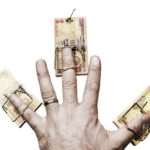The Battle to Tame Bihar
The brief history of an anarchy
 Chinki Sinha
Chinki Sinha
 Chinki Sinha
|
16 Dec, 2012
Chinki Sinha
|
16 Dec, 2012
/wp-content/uploads/2015/11/tame-1.jpg)
The brief history of an anarchy
Faces surveyed the city from the walls days before the massive 4 November Adhikar rally Chief Minister Nitish Kumar had called to demand ‘special state’ status for Bihar. One of those faces was of Mokama MLA Anant Singh, a state bahubali (strongman) and self-styled chhote sarkar, who had campaigned for Nitish in Barh first in 2005 and then again in 2010. Soon after Nitish came to power in 2005, he had ordered that an FIR be registered against this very Anant Singh—for usurping prime land in Patna’s Fraser Road neighbourhood to build malls—who is now part of the new alliances Nitish is forming. But no criminal cases have been registered against Singh since 1994. In his wide-brimmed hat and black shades, Singh, who used to keep a python in his state residence and sometimes rides to the Vidhan Sabha in a horse-drawn carriage, looks comic. He was gifted a Mercedes by a loyalist, but the luxury car is not much in use because the city roads are not up for luxury drives. Like Anant Singh’s portrait, Patna was plastered before the rally with posters of men who have been to prison and have criminal cases against them. At the rally, they were there with the Chief Minister.
When he was first elected in 2005, Nitish Kumar said he would usher in the Rule of Law in Bihar. It would seem he meant it. There has been a noticeable drop in the number of violent crimes, and where the streets were once deserted after twilight hours, today malls and restaurants are open past midnight. Massive parks with manicured lawns and installations by expat artists have been inserted in the city’s landscape. In his second term, Nitish Kumar sells the illusion of ‘vikas’ (development). But there is also an uncomfortable shift from the promised Rule of Law in the state. The posters are a telltale sign.
Memories of that afternoon sometime in the mid-1990s, when we were in our teens, are still vivid. We were sitting on the terrace of our house in Patna’s Mahendru PO neighbourhood when we saw a huge crowd surge towards the house. They were chasing this young man, who looked stricken with fear and now out of breath. He knew he wouldn’t make it. They shot him right in front of us. We knew him. This was the son of the woman who delivered milk at our place. Nobody did anything, and that look of terror on his face before he was put down maimed us too.
A few years later, in 1999, Shilpi Jain was raped and murdered. The CBI closed the case citing lack of evidence. Sadhu Yadav, the brother-in-law of then Chief Minister Lalu Prasad and one of the accused in the case, had refused a DNA test. Such was the effrontery of the man that he used to travel to court in the Chief Minister’s official vehicle. There were candlelight vigils for days in Gandhi Maidan, and the story made headlines. But those who had killed Shilpi knew the law would never catch up with them.
Shilpi was my senior in school and college. She had been crowned Miss St Joseph’s Convent and was quite the head-turner on campus. The DNA reports of the case suggested she had been raped by more than one person. Her brother was kidnapped a few years later when he tried to get the case reopened. He was later rescued by the police but the horror of it lingers in the collective memory of those who knew Shilpi.
There were too many of these gruesome murders and kidnappings at the time to recount. In those days, even Abhyanand, who would later acquire quite a reputation for law enforcement as Director General of Police, used to send an old constable with his son when he went for his tuitions. His son would ask him why, and though Abhyanand knew the constable could hardly offer any resistance if anything were to happen, he still did it for his peace of mind. The fear reflex had become ‘normal’.
In 2005, when he first came to power, Nitish Kumar told a meeting of senior police officials that he had promised to end “jungle raj” and he would keep his word. If they wanted a new law, he could make that happen. If they needed money, the coffers would be opened. But law and order had to be fixed. Whatever it took.
Abhyanand, who was Assistant Ins- pector-General of Police at the time, knew the score. He knew the scale of the challenge in a state where guns were as commonplace as grocery and killings and kidnappings had stopped being news. He told Nitish he didn’t want the money, nor another law. There were enough laws already; their implementation was the question. He had already played a hand in conducting fair elections in 2005.
BB Tandon, then Chief Election Com- missioner, had called him and asked how he would conduct elections in a state where booth capturing was the norm. (In the ‘dark days,’ I remember, going to a polling booth with my family. “Go home, your votes have been cast,” we were told by some gun-toting men.) Abhyanand had replied he couldn’t promise that there would be no violence, but he could ensure a “somewhat fair” election. Three bureaucrats, who had known each other as fellow administrators in Bihar, got together to study the polling process. They devised a simple method of flagging suspect booths—if 80 per cent of the votes cast in a booth had gone to one party, they would consider it ‘captured’. Also, if 80 per cent of the votes in a booth were not cast, it would be marked.
They even hired a machine from France that would capture the faces of those who came to vote, and would play it over to see if the same people had turned up more than once. “An election is as fair as the list of voters,” Abhyanand had said to the election commissioner.
To correct voters’ lists, the Election Commission studied the last census conducted in the state, and found there were voters in excess of the census records. They also introduced random assigning of police to polling stations.
“I was no stranger to policing. I had grown up in a police family. My father was a policeman,” Abhyanand said. His father was a former DGP of Bihar. Abhyanand had not wanted to be a cop.
He liked physics. He still mentors students at the Rahmani 30 Coaching Centre in Patna. He was at Delhi University studying physics when he got into an argument with a professor and returned to Bihar. He wasn’t very happy with the state of teaching at Patna University. He appeared for the civil services examination, cleared it in his first attempt, and joined the Indian Police Services.
Abhyanand decided to invoke the 1959 Arms Act to keep criminals off the streets. “We looked at cases of illicit firearms, and figured that most criminals had been arrested at least once for possession of firearms and had a case registered against them. Only courts can punish [offenders] in our criminal justice system and we thought this was the easiest way to put them behind bars,” he said.
Since policemen are the primary witnesses under the Arms Act, it was easier to frame charges and fast-track courts could then deliver speedy judgments. That is how Shahabuddin, the dreaded don from Sivan and a member of Lalu’s RJD, was put behind bars. He is a lifer in three cases. At one point during those two years that Abhyanand served as AGP, there were seven or eight life imprisonments a day. They were able to send around 75,000 criminals to jail in the first half of Nitish’s first term as Chief Minister. Abhyanand was then transferred to the Information Technology department where he spent a few years. In 2010, when Nitish Kumar won a second time, he called Abhyanand to say he would be made DGP of the state.
Violent crime had been contained, and was down by almost 30 per cent from the time Nitish first took office, but for the police there was still a lot of work left to be done. Their first goal was to reduce visible crime. Guns had to be taken off the streets. They started raiding illegal arms manufacturing units from where the ubiquitous kattas (handmade local guns) came.
When he took over as DGP in 2011, Abhyanand knew the police would have to do some unlearning. They would have to focus on investigations, pursue trials, and go beyond controlling visible crime. He set up an Economic Offences Unit, and started building forensic labs to assist investigations. Abhyanand has two more years before he retires, and spends a few hours after dinner every day touching base with police officials who need help with cases.
With elections due again in 2014, communal violence is on an upswing in Bihar. At Abhyanand’s junta durbar, people queue up every day with a list of grievances. He deals with them patiently, seldom losing his temper. There is a young girl who comes in with a complaint about being harassed by local men. He had already issued an arrest warrant for the eveteasers, but now their friends are causing trouble. Abhyanand picks up the phone, and calls the superintendent, and tells him to look into the matter. This is also a way of trying to understand who is working, and how.
“Investigation is the key to law and order,” he says. “From December this year, we will be putting out DNA reports (to bolster the case for the prosecution). The police [here] never conducted ‘searches’; they did ‘raids’, which is a militant sort of word. I told the Chief Minister that I wanted to concentrate on economic crimes. I have a schematic diagram.”
And then he takes a piece of paper and quickly draws rectangular boxes indicating a parallel state.
“If we go after violent crimes, we are only operating in the parallel state. Then we protect the parallel state and not the actual state. I am trying to remove the parallel state in the police, too,” he says. “Black money is being created. They have so much power that they can upset the apple cart.”
Policing a state where the mafia has always been strong, and where regional strongmen are an important part of the political game, requires him to come up with new methods of dealing with situations. For example, when the Chief Minister’s convoy was attacked in October this year in Khagaria, professional video cameramen he had hired got the culprits on tape.
But despite these initiatives, not all is well nor even better. According to State Election Commission data, the JD-U, the party in power, has the most MLAs with criminal cases pending against them. “It is easy to raise questions. We are trying. The question is whether we can legally frame charges and build a case. We are mapping the city, looking into property deals and figuring out how we can crack the syndicate,” says Abhyanand.
The state was pushed to the brink in Lalu’s era, and now even a little progress seems like a success story. There was no Rule of Law in Bihar. Chargesheets were prepared keeping in mind the political affiliations of the accused. At least, according to senior police officials, in Nitish’s regime, the police have a free hand. “The CM can’t change the whole system. There is a lakshman rekha [for the police as well as the CM]. We have limited powers. It is unreasonable to expect the police to do everything, to solve everything,” he says.
Praveen Vashistha, IG, Economic Offences Unit, says with economic development, overall crime will also increase. So, now the police has to look at ways to rein in crime of a different kind because it will eventually abet violent crime. For example, they dug out a provision from 1944 that empowers the Station House Officer, the senior police official of an area, to take over ‘unclaimed property’. Ritlal Yadav, a local strongman with more than 20 cases pending against him, owned benami property in Danapur. The SHO took over the property, and now Yadav has to prove it belongs to him, in which case he will have to face other charges. To take on bigger mafia, more planning is needed because they have money and connections.
At his official residence, beyond the makeshift tents of the security personnel, Lalu is sitting in the courtyard surrounded by journalists and party members. It is early December and he has just returned from Delhi. In front of him lies a heap of newspapers that speak about the report card on development Nitish Kumar has presented to the media. He tosses away a newspaper with
contempt. This time round, he is talking about change. Lalu, who plunged the state into its infamous anarchy, is preparing to take out a Parivartan Yatra.
Nitish Kumar is also talking of change. He is touring the state with a brag-list of the government’s achievements and another of its new promises. One visible face of this development in Patna is its newlook parks. Earlier, a few of them lay scattered in some neighbourhoods but these had become grazing fields for cattle or were put to use by slum dwellers to wash and dry clothes and to defecate. The new administration wants to create public spaces that can be used for recreation and sports, and wants to convert Patna into ‘a city of parks’.
Driving around the city on my last visit here, I was taken aback by the massive undertaking to build these public parks. Where there used to be a prison near the railway station, there is now a park with grand stupas and marble statues. It is a site well chosen, for it is what a visitor will first see when he emerges from Patna railway station.
At the Rajdhani Vatika Smriti Park just behind the old secretariat building near the airport, there is a tower with scissors and knives jutting out of it. This is artist Sanjeev Sinha’s installation—an interpretation of crime and violence in today’s world. Shri Krishnapuri Park at Kidwaipuri; Manju Devi Park at Kankarbagh (this was built in the memory of Nitish Kumar’s wife, late Manju Kumari); Rajdhani Vatika Smriti Park and the ones at Sri Krishnapuri and Mahatma Gandhinagar in Kankarbagh are some of these new parks. Fifty-nine of them have been planned for Patna alone. A total of 133 parks are slated to come up in the state. There is talk of a new airport and of reviving the Nalanda University of yore. A new university campus is being built near the historical site. The drive forward, it appears, is also a ride back into the state’s gloried past—restoring and recreating its old landmarks.
As teenagers, we looked at the top of Biscoman Towers, where there was supposedly a revolving restaurant (which never really opened), and wondered how it must feel to be sitting in there. For years, the restaurant was a mystery. It was half-finished and perched on a building that housed government offices. At ground level, there used to be a Chinese restaurant, and my earliest memories of childhood include going there for soup and noodles. Later we abandoned that ritual family outing because it wasn’t safe. The eatery shut down too.
During those years, I remember my father coming back late at night one Sunday, and saying he would no longer go to the Sunday get-together with friends in Patliputra. On his way back that night, his car was stopped, and they asked him for money, and said his name was on the hit list. The city’s descent into lawlessness was rapid. As were the migrations that followed. A few returned when Bihar seemed to be on its road to recovery, as the malls glittered in the night and the revolving restaurant actually started revolving. We felt a certain pride at Patna’s ‘revival’. We felt we had finally begun to heal. But the healing is still only skin deep. Poverty, by some accounts, has gone up since Lalu’s time. And there has lately been a spike in incidents of communal violence. Then there are the new alliances of Nitish, reminding us of the dark days of Bihar before his time.
With memory as my guide, I went back recently to find my city, which I had lost to 15 years of Lalu’s rule. One evening, I went to the revolving restaurant and looked down at Patna, ravaged in the past, limping to normalcy. I saw the lights flowing through its streets like lava and the river flowing on the left, dark and forlorn, shifting to the side as the city expanded.

/wp-content/uploads/2025/08/Cover_Game-changer.jpg)











More Columns
The Usual Gangsters Kaveree Bamzai
Kani Kusruti: Locarno Calling Kaveree Bamzai
Return to Radio Kashmir Kaveree Bamzai